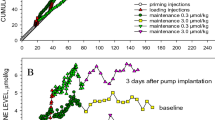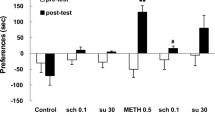Abstract
The effect of chronic D-1 and/or D-2 dopamine receptor blockade on apomorphine-induced behaviors was studied in rats treated for 21 days with the selective D-1 antagonist SCH23390, the predominantly D-2 antagonist haloperidol, and the combination of the two drugs at the same daily doses (0.1 and 1 mg/kg respectively). Apomorphine (0.3 mg/kg) 4 days following the last injection of the drugs increased (49–70%) stereotypic behavior in all animals as compared to saline-treated controls. Although the SCH23390-induced increase was lower than haloperidol-induced supersensitivity, stereotypies after combined administration of both drugs did not differ significantly from either, suggesting that the effects of the two drugs are not additive. Underlying receptor changes and modified D-1/D-2 receptor interactions may account for the participation of both receptor subtypes to the development of neuroleptic-induced dopaminergic supersensitivity.
Similar content being viewed by others
References
Baldessarini RJ, Tarsy D (1979) Relationship of the actions of neuroleptic drugs to the pathophysiology of tardive dyskinesia. Int Rev Neurobiol 21:1–45
Barone P, Davis TA, Braun AR, Chase TN (1986) Dopaminergic mechanisms and motor function: characterization of D-1 and D-2 receptor interactions. Eur J Pharmacol 123:109–114
Barone P, Tucci I, Parashos SA, Chase TN (1988) Supersensitivity to a D-1 agonist and subsensitivity to a D-2 agonist following chronic D-1 receptor blockade. Eur J Pharmacol 149:225–232
Braun AR, Barone P, Chase TN (1986) Interaction D1 and D2 dopamine receptors in the expression of dopamine agonist induced behaviors. In: Breese GR, Creese I (eds) Neurobiology of central D1 dopamine receptors. Plenum Press Corporation, New York, pp 151–166
Chipkin RE, McQuade RD, Iorio LC (1987) D-1 and D-2 binding site upregulation and apomorphine-induced stereotypy. Pharmacol Biochem Behav 28:477–482
Christensen AV, Arnt J, Hyttel J, Larsen JJ, Svendsen O (1984) Pharmacological effects of a specific dopamine D-1 antagonist SCH23390 in comparison with neuroleptics. Life Sci 34:1529–1540
Christensen AV, Arnt J, Sevendsen O (1985) Pharmacological differentiation of D-1 and D-2 antagonists after single and repeated administration. In: Casey D, Chase TN, Christensen AV, Gerlach J (eds) Dyskinesia—research and treatment. Springer, Berlin Heidelberg New York Tokyo, pp 182–190
Costall B, Naylor RJ (1973) Neuroleptic and non-neuroleptic catalepsy. Arzneimittelforschung 23:674–683
Creese I, Chen A (1985) Selective D-1 dopamine receptor increase following chronic treatment with SCH23390. Eur J Pharmacol 109:127–128
Creese I, Sibley DR, Hamblin MN, Leff SE (1983) The classification of dopamine receptors: relationship to radioligand binding. Annu Rev Neurosci 6:43–71
Ernst AM (1967) Mode of action of apomorphine and dexamphetamine on gnawing compulsion in rats. Psychopharmacologia 10:316–323
Fleminger S, Rupniak NMJ, Hall MD, Jenner P, Marsden CD (1983) Changes in apomorphine-induced stereotypy as a result of subacute neuroleptic treatment correlates with increased D-2 receptors but not with increases in D-1 receptors. Biochem Pharmacol 32:2921–2927
Fray PJ, Sahakian BJ, Robbins TW, Koob GF, Inversen SD (1980) An observational method for quantifying the behavioural effects of dopamine agonists: contrasting effects of d-amphetamine and apomorphine. Psychopharmacology 69:253–259
Gianutsos G, Drawbaugh RB, Hynes MD, Lal H (1974) Behavioural evidence for dopaminergic supersensitivity after haloperidol. Life Sci 14:887–898
Goetz CG, Carvey PM, Tanner CM, Klawans HL (1984) Neuroleptic-induced dopamine hyposensitivity. Life Sci 34:1475–1479
Hess EJ, Albers LJ, Le H, Cresse I (1986) Effects of chronic SCH23390 treatment on the biochemical and behavioral properties of D-1 and D-2 dopamine receptors: potentiated behavioral responses to a D-2 dopamine agonist after selective D-1 dopamine receptor upregulation. J Pharmacol Exp Ther 238:846–854
Hyttel J, Christensen AV, Arnt J (1983) Neuroleptic classification: Implications for tardive dyskinesia. Mod Probl Pharmacopsychiatry 21:49–64
Jenner P, Marsden CD (1986) Interactions between D-1 and D-2 receptors resulting from chronic neuroleptic action. Clin Neuropharmacol [Suppl] 9:26–28
Kilts CD, Dew KL, Ely TD, Mailman RB (1985) Quantification of R-(+)-7choloro-8-hydroxy-1-phenyl1,2,3,4,5,tetrahydro-1H-3-methyl-3-benzazepine in brain and blood by use of reversed-phase high performance liquid chromatography with electrochemical detection. J Chromatogr 342:452–457
Mailman RB, Schulz DW, Lewis MH, Staples L, Rollma H, Dehaven DL (1984) SCH 23390: a selective D-1 dopamine antagonist with potent D-2 behavioral actions. Eur J Pharmacol 101:159–160
Memo M, Pizzi M, Missale C, Carruba MO, Spano RF (1987) Modification of the function of the D-1 and D-2 dopamine receptors in striatum and nucleus accumbens of rats chronically treated with haloperidol. Neuropharmacology 26:477–480
Molloy AC, Waddington JL (1984) Dopaminergic behavior stereo-specifically promoted by the D1 agonist R-SK & F38393 and selectively blocked by the D1 antagonist SCH23390. Psychopharmacology 82:409–410
Parashos SA, Barone P, Tucci I, Chase TN (1987) Attenuation of D-1 antagonist-induced D-1 receptor upregulation by concomitant D-2 receptor blockade. Life Sci 41:2279–2284
Porceddu ML, Ongini E, Biggio G (1985) 3H-SCH23390 binding sites increase after chronic blockade of D-1 dopamine receptors. Eur J Pharmacol 118:367–370
Rastogi SK, Rastogi RB, Singhal RL, Lapierre YD (1983) Behavioral and biochemical alterations following haloperidol treatment and withdrawal: the animal model of tardive dyskinesia reexamined. Prog Neuropsychopharmacol. Biol Psychiatry 9:153–164
Saller CF, Salama AI (1986) D-1 and D-2 dopamine receptor blockade: interactive effects in vitro and in vivo. J Pharmacol Exp Ther 236:714–720
Schelkunov EL (1967) Adrenergic effects of chronic administration of neuroleptics. Nature 214:1210–1212
Schulz DW, Staples L, Mailman RB (1985) SCH23390 causes persistent antidopaminergic effects in vivo: evidence for long-term occupation of receptors. Life Sci 36:1941–1948
Walters JR, Bergstrom DA, Carlson JH, Chase TN, Braun AR (1987) D1 dopamine receptor activation required for postsynaptic expression of D2 agonist effects. Science 236:719–722
Author information
Authors and Affiliations
Rights and permissions
About this article
Cite this article
Parashos, S.A., Barone, P., Marin, C.A. et al. Haloperidol- and SCH23390-induced dopaminergic supersensitivities are not additive in the rat. Psychopharmacology 98, 189–192 (1989). https://doi.org/10.1007/BF00444690
Received:
Accepted:
Issue Date:
DOI: https://doi.org/10.1007/BF00444690




